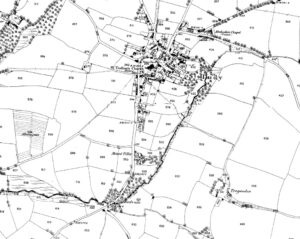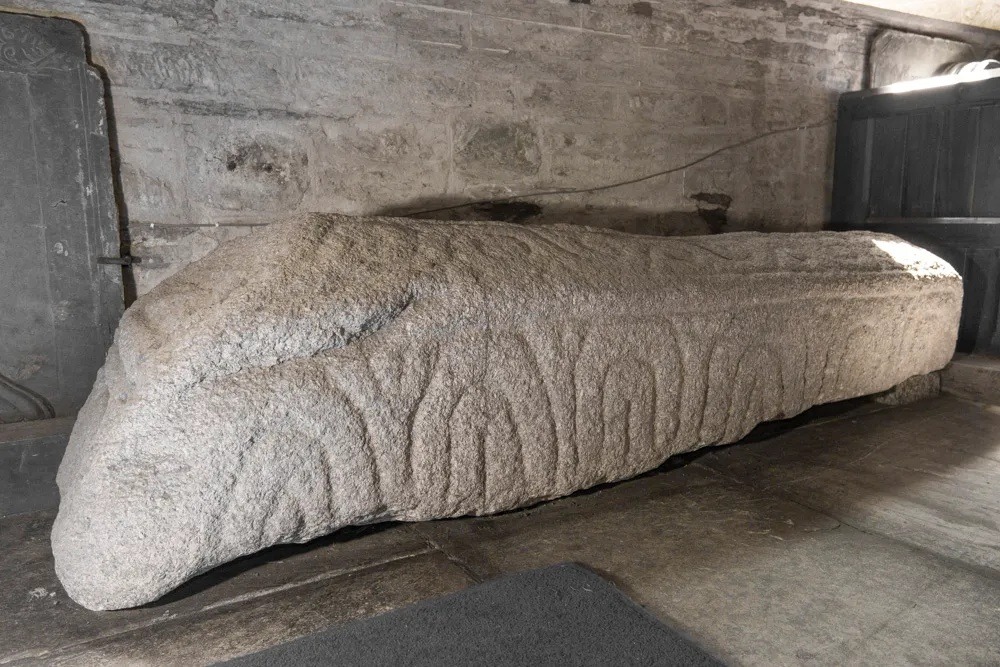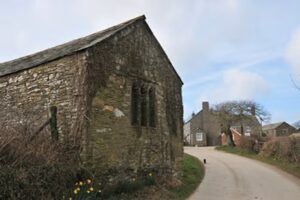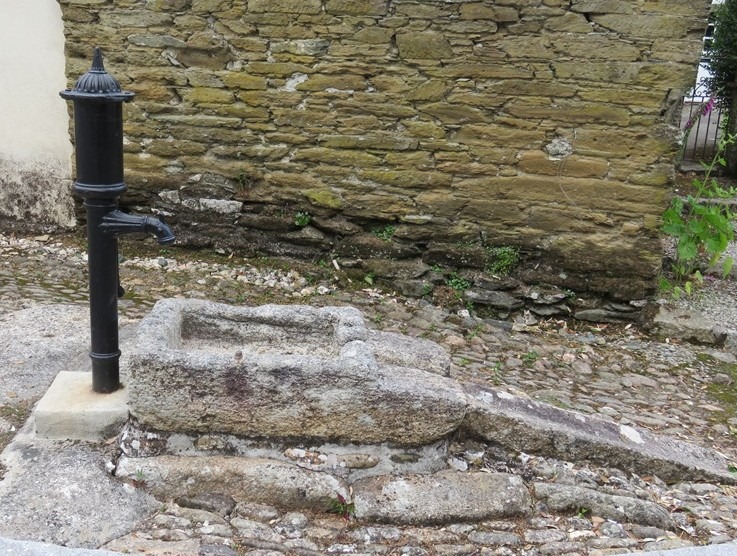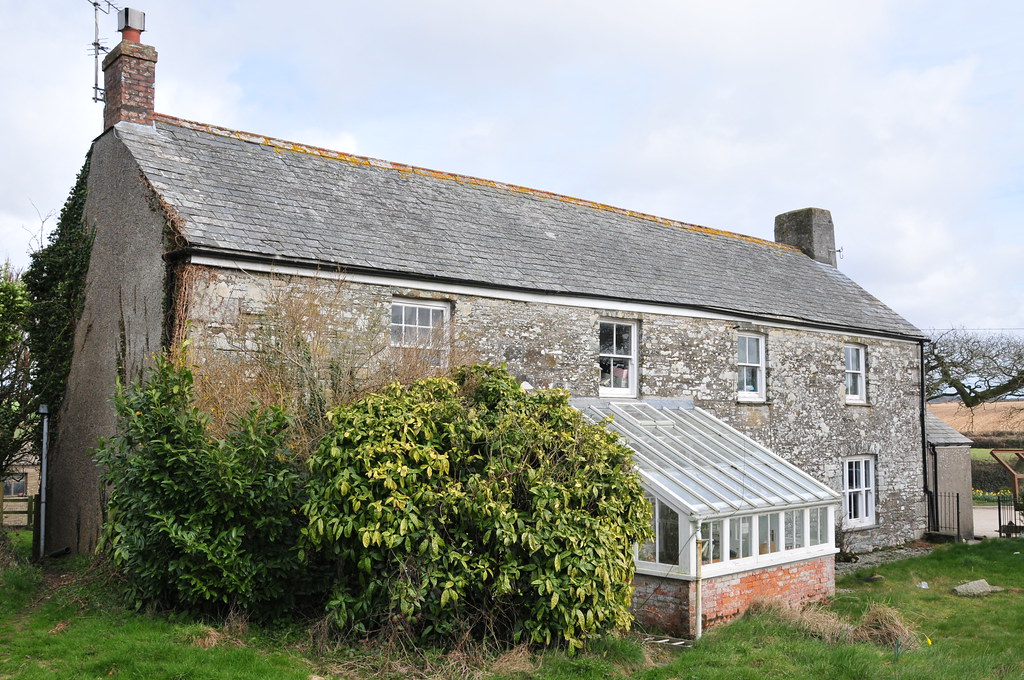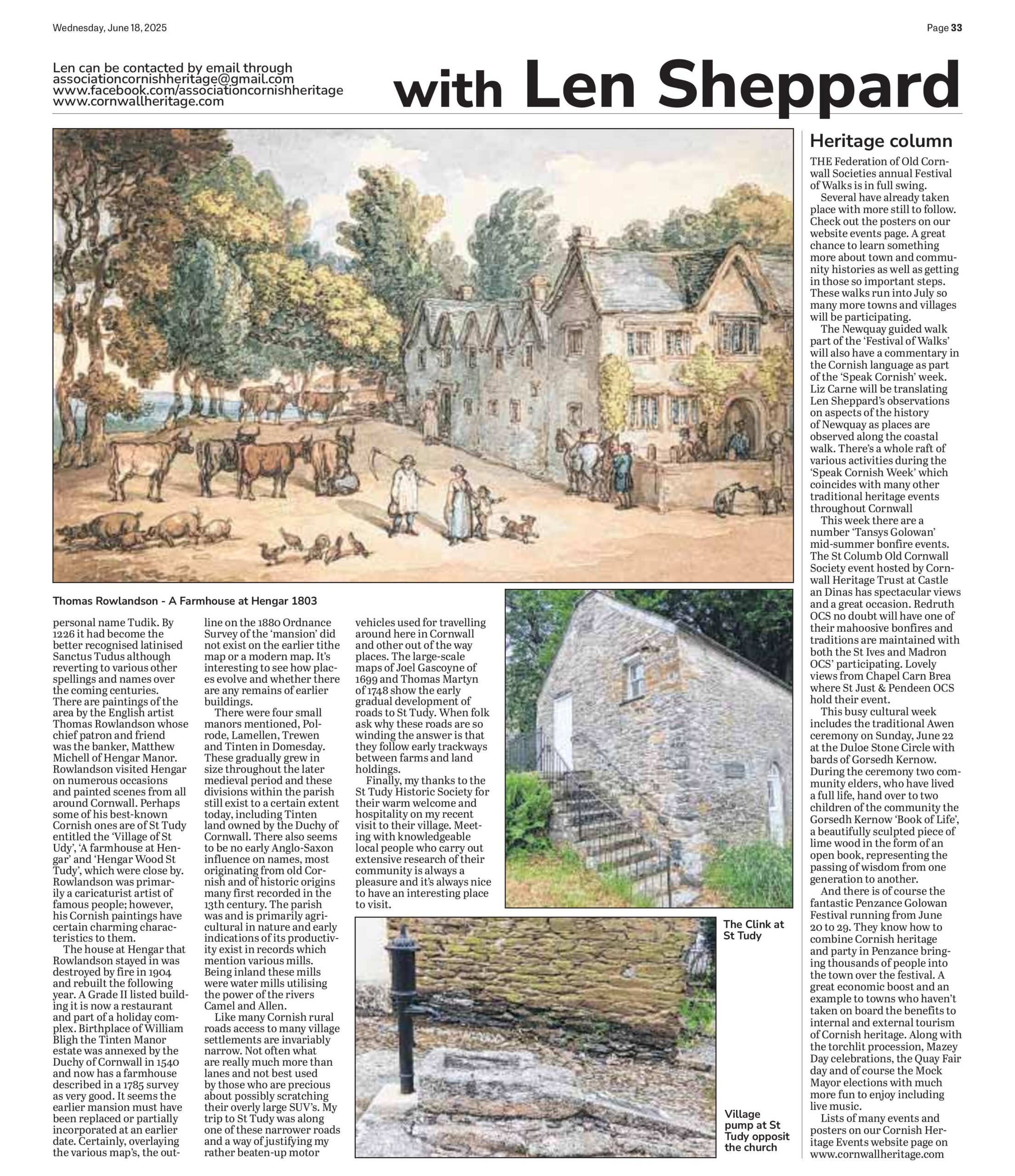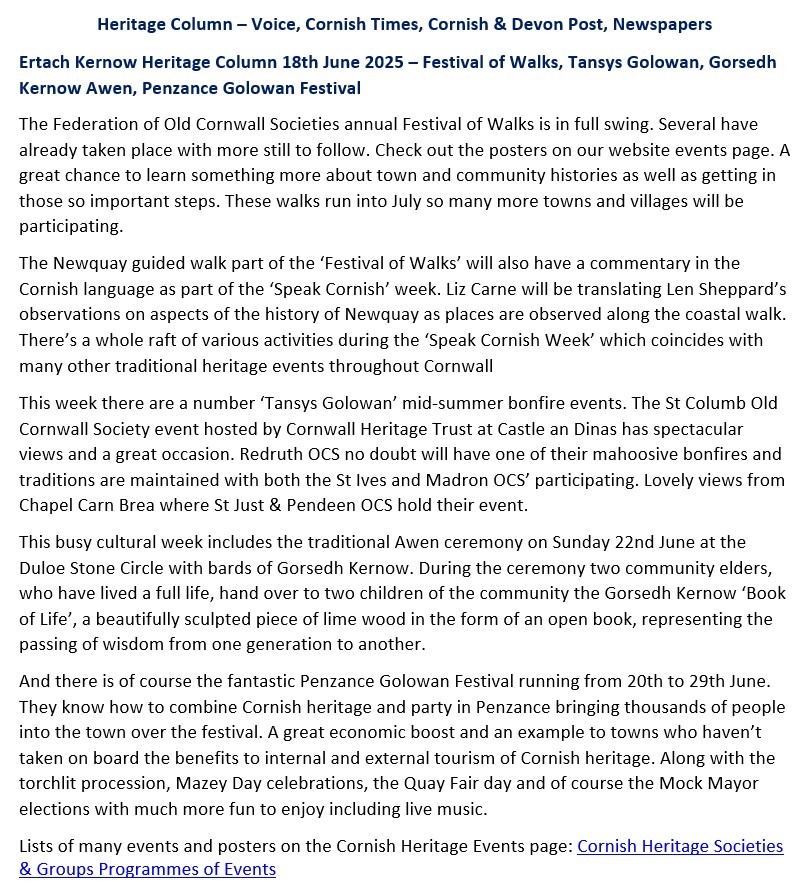Ertach Kernow - St Tudy. Award winning village in an ancient setting
St Tudy is a lovely traditional Cornish village and community. So much so that it has won a number of awards including the coveted and prestigious Queen’s Award for Voluntary Service for their community shop. My recent visit was to give a talk in their well-appointed village hall, including a bar. This gave me the opportunity to enjoy the centre of the village and visit their Grade I listed 14th/15th century church.
The area around St Tudy has been occupied far back in time to the Iron Age and contain a number of ancient rounds. Rounds as they are known in Cornwall are small settlements which have some fortification, usually a single bank and ditch. Whether these were created to protect the community from external attack by other people or wild animals, perhaps to keep their own domesticated enclosed, or a combination is not fully known. However, the abundance of these within an area of current day settlements provide a local history of occupation covering thousands of years.
The location of the church site thought to date an earlier church many centuries before the existing building was constructed is believed to be within an ancient round given its circular shape. The parish of St Tudy which of course includes the village from which it takes its name lay within the historic hundred of Triggshire created during the Anglo-Saxon period as an administrative unit.
As always click the images for larger view
Information about the church itself has been included within a sizeable booklet recently updated in 2017 by the very proactive St Tudy History Group available from the church. The earlier church believed to have stood on this site was followed later by a Norman church. A rebuild in the 15th century has left virtually nothing of the earlier construction. Like many churches in Cornwall there were extensive repairs carried out in the 19th century, firstly in the 1830’s and later in 1873 by well-known church architect J. P. St Aubyn. A little later in 1888 there was additional work undertaken on the tower and the church bells. Various other larger repairs and restoration work took place throughout the 20th century with a complete reroofing in 2005. The 15th century 68-foot tower was a slightly later addition to the church and holds six bells on a steel frame which replaced the 1888 oak frame in 1974. The bells date from 1751 through to 1923.
Within the church there is a traditional Norman font and an unusual stone, believed to be a tombstone with decorative carvings. Known as a hogback gravestone, or in Cornwall a coped stone, it is one of five similar hogbacks found in Cornwall. The others showing both Scandinavian and local Cornish design influences can be found at Lanivet, St Buryan and Phillack as well as one recent discovered in Padstow as a gatepost. Discovery of these unusual stones leads us back to times when the Cornish were interacting with Vikings or at least Scandinavian traders and warriors. Originally located in the churchyard it was moved into firstly the porch and later the church to protect it from weathering.
An interesting feature of many churches are the historic memorials and often grave monuments found within, often still on the floors. Sadly, in many churches these have been covered in tiles by over enthusiastic Victorian restorers which is such a shame, but happily not the case in St Tudy. Although worn some of these slates are just about readable or the text has been recorded by earlier historians. There are some wonderful Delabole slate monuments on the walls, said to be the best in Cornwall. These includes those to the Nicholl family; 17th century and Onslow’s of Hengar Manor from the 18th century. There are many more, and for those folk interested in viewing historic church monuments a visit to St Tudy church is recommended.
An interesting feature opposite the church in the centre of St Tudy is the old village pump outside the old forge where a binding wheel used by the village blacksmith for use in making wheels can be seen. Restored for the millennium this was a great way of both creating an event memorial and conserving local heritage. Village pumps are often overlooked nowadays but it would seem that there are 165 recorded for Cornwall with a further three located in St Tudy.
A number of famous people are associated with St Tudy including a recent Governor of the Bank of England, Lord Eddie George who took the title Lord George of St Tudy. An interesting speaker I attended a lecture and remember him explaining how the UK avoided a recession by shopping its way through that period. Other more historic figures include baronet Admiral Sir Richard Onslow and Admiral William Bligh, the ‘Captain Bligh’ of the Bounty mutiny fame. Bligh's ancestral home was Tinten Manor in St Tudy and Onslow’s country seat at Hengar Manor. Anthony Nicholl a member of parliament was one who was often in opposition to Cromwell’s regime although he was an advisor to the Major-General’s and was appointed High Sheriff of Cornwall in 1657.
There is a strange small building on the edge of the churchyard named the Clink. The construction of this 17th century Grade II listed building is rubble built with a rag slate roof. It was commended by the Cornish Buildings Group for its 1986 restoration and has had multiple uses during its existence. One can be guessed from its name as a lockup for constables during the days when the churchwardens had such responsibilities. Originally a church ale house it has also served as a village school, meeting room and for community activities. Lovely to see such buildings valued and used whereas in some Cornish towns they may have been torn down for development.
As with most Cornish communities St Tudy had built Methodist chapels. Despite John Wesley preaching there in 1746 St Tudy’s first wasn’t built until 1811 when constructed by its eight members and then licenced in 1824. The Wesley Methodist Association built their meeting house, now two residential properties known as Chapel House in 1846. The current Methodist Chapel was built in 1869 and it together with the school room and western wall are Grade II listed. There were other earlier chapels and non-conformist places of worship within the parish.
St Tudy was mentioned in Domesday of 1086 as Heglostudic, taking eglos for church along with the saint’s personal name Tudik. By 1226 it had become the better recognised latinised Sanctus Tudus although reverting to various other spellings and names over the coming centuries. There are paintings of the area by the English artist Thomas Rowlandson whose chief patron and friend was the banker, Matthew Michell of Hengar Manor. Rowlandson visited Hengar on numerous occasions and painted scenes from all around Cornwall. Perhaps some of his best-known Cornish ones are of St Tudy entitled the ‘Village of St Udy’, ‘A farmhouse at Hengar’ and ‘Hengar Wood St Tudy’, which were close by. Rowlandson was primarily a caricaturist artist of famous people; however, his Cornish paintings have certain charming characteristics to them.
The house at Hengar that Rowlandson stayed in was destroyed by fire in 1904 and rebuilt the following year. A Grade II listed building it is now a restaurant and part of a holiday complex. Birthplace of William Bligh the Tinten Manor estate was annexed by the Duchy of Cornwall in 1540 and now has a farmhouse described in a 1785 survey as very good. It seems the earlier mansion must have been replaced or partially incorporated at an earlier date. Certainly, overlaying the various map’s, the outline on the 1880 Ordnance Survey of the ‘mansion’ did not exist on the earlier tithe map or a modern map. It’s interesting to see how places evolve and whether there are any remains of earlier buildings.
There were four small manors mentioned, Polrode, Lamellen, Trewen and Tinten in Domesday. These gradually grew in size throughout the later medieval period and these divisions within the parish still exist to a certain extent today, including Tinten land owned by the Duchy of Cornwall. There also seems to be no early Anglo-Saxon influence on names, most originating from old Cornish and of historic origins many first recorded in the 13th century. The parish was and is primarily agricultural in nature and early indications of its productivity exist in records which mention various mills. Being inland these mills were water mills utilising the power of the rivers Camel and Allen.
Like many Cornish rural roads access to many village settlements are invariably narrow. Not often what are really much more than lanes and not best used by those who are precious about possibly scratching their overly large SUV’s. My trip to St Tudy was along one of these narrower roads and a way of justifying my rather beaten-up motor vehicles used for travelling around here in Cornwall and other out of the way places. The large-scale maps of Joel Gascoyne of 1699 and Thomas Martyn of 1748 show the early gradual development of roads to St Tudy. When folk ask why these roads are so winding the answer is that they follow early trackways between farms and land holdings.
Finally, my thanks to the St Tudy Historic Society for their warm welcome and hospitality on my recent visit to their village. Meeting with knowledgeable local people who carry out extensive research of their community is always a pleasure and it’s always nice to have an interesting place to visit. I hope that many readers will take the opportunity to visit St Tudy in their travels around Cornwall.

![Thomas Rowlandson [Cornwall] - St Udy. Thomas Rowlandson [Cornwall] - St Udy.](https://www.cornwallheritage.com/wp-content/uploads/2025/06/Thomas-Rowlandson-Cornwall-St-Udy-300x207.jpg)
